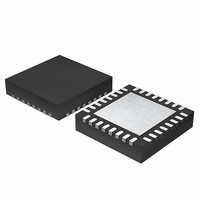EFM32G200F64 Energy Micro, EFM32G200F64 Datasheet - Page 157

EFM32G200F64
Manufacturer Part Number
EFM32G200F64
Description
MCU 32BIT 64KB FLASH 32-QFN
Manufacturer
Energy Micro
Series
Geckor
Datasheets
1.EFM32G200F16.pdf
(63 pages)
2.EFM32G200F16.pdf
(10 pages)
3.EFM32G200F16.pdf
(463 pages)
4.EFM32G200F16.pdf
(136 pages)
Specifications of EFM32G200F64
Core Processor
ARM® Cortex-M3™
Core Size
32-Bit
Speed
32MHz
Connectivity
EBI/EMI, I²C, IrDA, SmartCard, SPI, UART/USART
Peripherals
Brown-out Detect/Reset, DMA, POR, PWM, WDT
Number Of I /o
24
Program Memory Size
64KB (64K x 8)
Program Memory Type
FLASH
Ram Size
16K x 8
Voltage - Supply (vcc/vdd)
1.8 V ~ 3.8 V
Data Converters
A/D 4x12b, D/A 1x12b
Oscillator Type
External
Operating Temperature
-40°C ~ 85°C
Package / Case
32-VQFN Exposed Pad
Processor Series
EFM32G200
Core
ARM Cortex-M3
Data Bus Width
32 bit
Data Ram Size
16 KB
Interface Type
I2C, UART
Maximum Clock Frequency
32 MHz
Number Of Programmable I/os
24
Number Of Timers
2
Operating Supply Voltage
1.8 V to 3.8 V
Maximum Operating Temperature
+ 85 C
Mounting Style
SMD/SMT
Minimum Operating Temperature
- 40 C
Lead Free Status / RoHS Status
Lead free / RoHS Compliant
Eeprom Size
-
Lead Free Status / Rohs Status
Details
Available stocks
Company
Part Number
Manufacturer
Quantity
Price
- EFM32G200F16 PDF datasheet
- EFM32G200F16 PDF datasheet #2
- EFM32G200F16 PDF datasheet #3
- EFM32G200F16 PDF datasheet #4
- Current page: 157 of 463
- Download datasheet (8Mb)
2010-09-06 - d0001_Rev1.00
After a START or repeated START condition, the bus master will transmit an address along with an R/
W bit. If there is no room in the receive shift register for the address, the bus will be held by the slave
until room is available in the shift register. Transmission then continues and the address is loaded into
the shift register. If this address does not pass address recognition, it is automatically NACK’ed by the
slave, and the slave goes to an idle state. The address byte is in this case discarded, making the shift
register ready for a new address. It is not loaded into the receive buffer.
If the address was accepted and the R/W bit was set (R), indicating that the master wishes to read from
the slave, the slave now goes into the slave transmitter mode. Software interaction is now required to
decide whether the slave wants to acknowledge the request or not. The accepted address byte is loaded
into the receive buffer like a regular data byte. If no valid interaction is pending, the bus is held until the
slave responds with a command. The slave can reject the request with a single NACK command.
The slave will in that case go to an idle state, and wait for the next start condition. To continue the
transmission, the slave must make sure data is loaded into the transmit buffer and send an ACK. The
loaded data will then be transmitted to the master, and an ACK or NACK will be received from the master.
Data transmission can also continue after a NACK if a CONT command is issued along with the NACK.
This is not standard I
If the master responds with an ACK, it may expect another byte of data, and data should be made
available in the transmit buffer. If data is not available, the bus is held until data is available.
If the response is a NACK however, this is an indication of that the master has received enough bytes
and wishes to end the transmission. The slave now automatically goes idle, unless CONT in I2Cn_CMD
is set and data is available for transmission. The latter is not standard I
The master ends the transmission by sending a STOP or a repeated START. The SSTOP interrupt
flag in I2Cn_IF is set when the master transmits a STOP condition. If the transmission is ended with a
repeated START, then the SSTOP interrupt flag is not set.
Note
If arbitration is lost at any time during transmission, the ARBLOST interrupt flag in I2Cn_IF is set, the
bus is released and the slave goes idle.
See Table 15.8 (p. 158) for more information.
The SSTOP interrupt flag in I2Cn_IF will be set regardless of whether the slave is
participating in the transmission or not, as long as SLAVE in I2Cn_CTRL is set and a STOP
condition is detected
2
C however.
...the world's most energy friendly microcontrollers
157
2
C.
www.energymicro.com
Related parts for EFM32G200F64
Image
Part Number
Description
Manufacturer
Datasheet
Request
R

Part Number:
Description:
KIT STARTER EFM32 GECKO
Manufacturer:
Energy Micro
Datasheet:

Part Number:
Description:
KIT DEV EFM32 GECKO LCD SUPPORT
Manufacturer:
Energy Micro
Datasheet:

Part Number:
Description:
BOARD PROTOTYPING FOR EFM32
Manufacturer:
Energy Micro
Datasheet:

Part Number:
Description:
KIT DEVELOPMENT EFM32 GECKO
Manufacturer:
Energy Micro
Datasheet:

Part Number:
Description:
MCU, MPU & DSP Development Tools TG840 Sample Kit
Manufacturer:
Energy Micro
Datasheet:

Part Number:
Description:
MCU, MPU & DSP Development Tools TG Starter Kit
Manufacturer:
Energy Micro
Datasheet:

Part Number:
Description:
MCU, MPU & DSP Development Tools TG108 Sample Kit
Manufacturer:
Energy Micro

Part Number:
Description:
MCU, MPU & DSP Development Tools TG210 Sample Kit
Manufacturer:
Energy Micro
Datasheet:

Part Number:
Description:
MCU, MPU & DSP Development Tools TG822 Sample Kit
Manufacturer:
Energy Micro
Datasheet:

Part Number:
Description:
MCU, MPU & DSP Development Tools TG230 Sample Kit
Manufacturer:
Energy Micro

Part Number:
Description:
SAMPLE KIT (SMALL BOX - CONTAINING 2 DEVICES)
Manufacturer:
Energy Micro

Part Number:
Description:
SAMPLE KIT (SMALL BOX - CONTAINING 2 DEVICES)
Manufacturer:
Energy Micro











